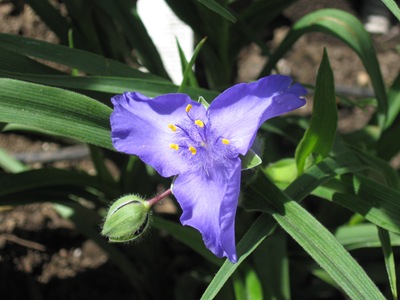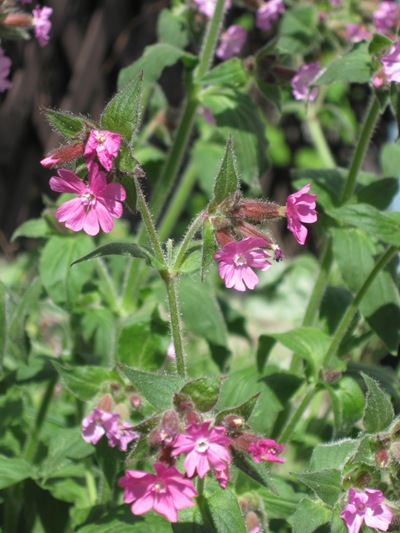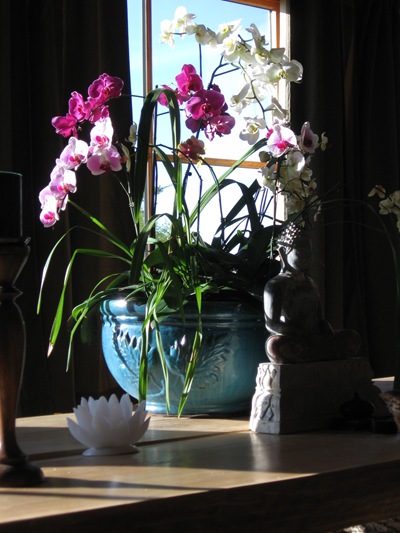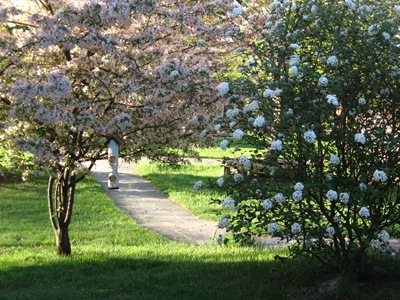One of the points stressed was that a facilitator should be prepared to give brief meditation instructions, and that these instructions should be Thich Nhất Hạnh’s instructions, not other teachers’. I realized that in my own meditation practice, I do draw on many different sources, some of which I can’t identify anymore. I need to get clearer again on what Thầy’s tradition teaches.

So I went back to Thầy’s books. He is in fact very consistent in his guidance about how and why to meditate. He is also consistent in instructing us to maintain mindfulness of our breath, our body, our thoughts and feelings and mind, throughout the day, no matter what we are doing. But for now, I want to focus on silent seated meditation. Over the next weeks, I will post pertinent passages from different books.
These excerpts are from The Miracle of Mindfulness.
How to meditate:Zen master Doc The says that when sitting in meditation, one should sit upright, giving birth to this thought, “Sitting here is like sitting on the Bodhi spot.” (p. 13)
The instant you sit down to meditate, begin watching your breath. At first breathe normally, gradually letting your breathing slow down until it is quiet, even, and the lengths of the breaths are fairly long. From the moment you sit down to the moment your breathing has become deep and silent, be conscious of everything that is happening in yourself. (p. 20)
Now begin to follow your breath and to relax all of your muscles. Concentrate on keeping your spinal column straight and on following your breath. As for everything else, let it go. Let go of everything. If you want to relax the worry-tightened muscles in your face, let the half smile come to your face. As the half smile appears, all the facial muscles begin to relax. …
Place your left hand, palm side up, in your right palm. let all the muscles in your hands, fingers, arm, and legs relax. Let go of everything. Be like the waterplants which flow with the current, while beneath the surface of the water the riverbed remains motionless. Hold on to nothing but your breath and the half smile. (p. 34-35)
During meditation, various feelings and thoughts may arise. If you don’t practice mindfulness of the breath, these thoughts will soon lure you away from mindfulness. But the breath isn’t simply a means by which to chase away such thoughts and feelings. Breath remains the vehicle to unite body and mind and to open the gate to wisdom. … Simply acknowledge [the] presence [of thoughts and feelings]. …
If there are no feelings or thoughts present, then recognize that there are no feelings or thoughts present. (p. 38)

Why meditate:
Why should you meditate? First of all, because each of us needs to realize total rest. (p. 33)
…While relaxation is the necessary point of departure, once one has realized relaxation, it is possible to realize a tranquil heart and clear mind. To realize a tranquil heart and clear mind is to have gone far along the path of meditation. (p. 37)
Thầy gives instruction as well in following the breath by counting out the length of the in-breath and the length of the out-breath. He also teaches the technique of counting "one" for an in-breath, "one" for an out-breath, then "two" for an in-breath and "two" for an out-breath, and so on up to "ten."
In addition, he quotes or paraphrases “The Sutra on the Full Awareness of Breathing” quite a bit. These sections are too long to excerpt, but the techniques are certainly central to Thầy's teaching. Especially “The Sutra on the Full Awareness of Breathing,” which is presented in wonderfully helpful detail in Breathe! You Are Alive. He refers to "The Sutra on the Four Establishments of Mindfulness" as well, which he investigates in Transformation and Healing. But you don't need to have read those books to make good use of the instruction he gives in this book.
There is one instruction which I didn’t include above, as I find it personally too unsettling to practice with. He suggests imagining yourself as a pebble effortlessly falling through water to the undisturbed streambed below. Finally your mind and body are at rest, like the pebble resting in the sand. When I have tried to use this image, I end up feeling breathless and having to stop. Unlike a pebble, I have to breathe,  and I can’t breathe while under water. I prefer the image he uses of a glass of cloudy apple juice, in which the pulp slowly settles until the juice is clear. I think he writes of that in The Sun My Heart.
and I can’t breathe while under water. I prefer the image he uses of a glass of cloudy apple juice, in which the pulp slowly settles until the juice is clear. I think he writes of that in The Sun My Heart.
The Miracle of Mindfulness was the first book by Thich Nhất Hạnh that I read and owned. I believe that I bought it in my college bookstore, back in the early 1980s. I returned to that same copy over the ensuing decades. I don’t have that copy anymore; I lent it to someone whom I never run into anymore. It’s hers now; I have bought a new copy for myself, which I would be happy to give away if someone seemed to be in great need of it.











